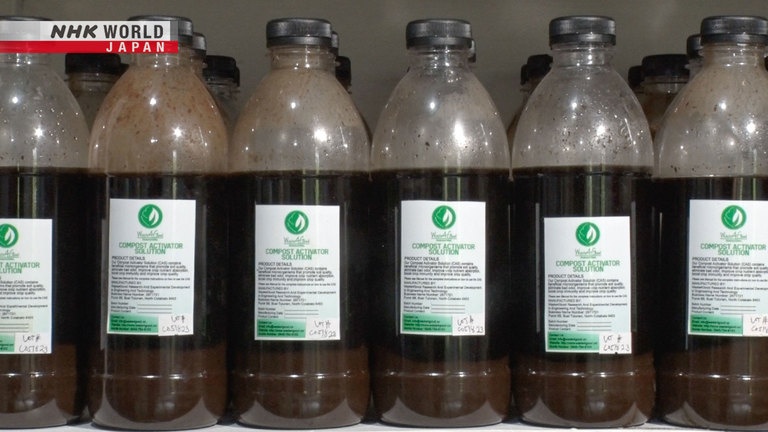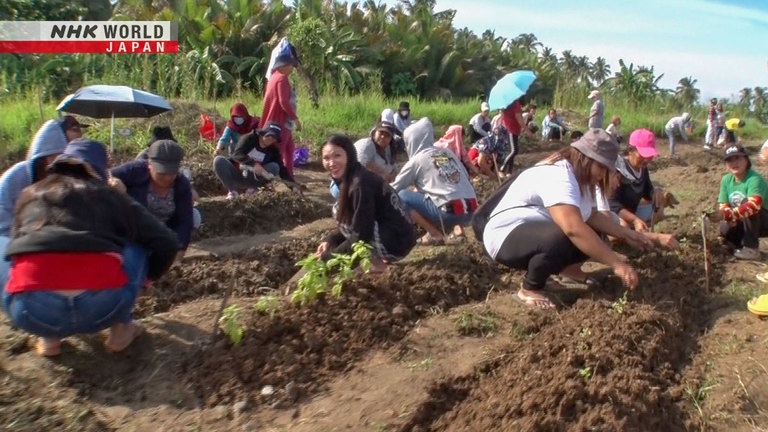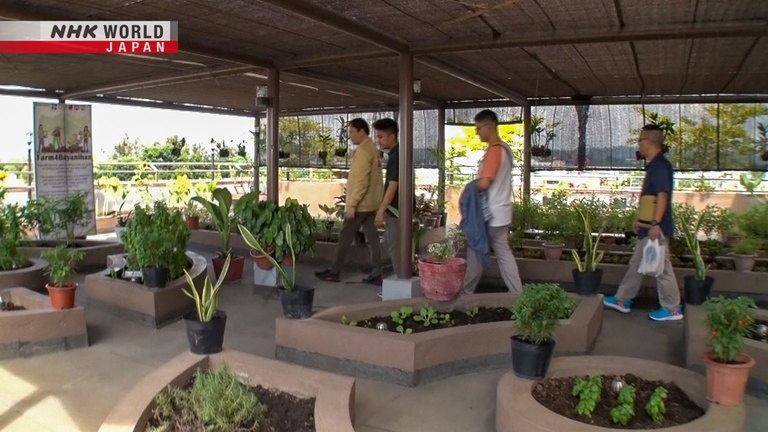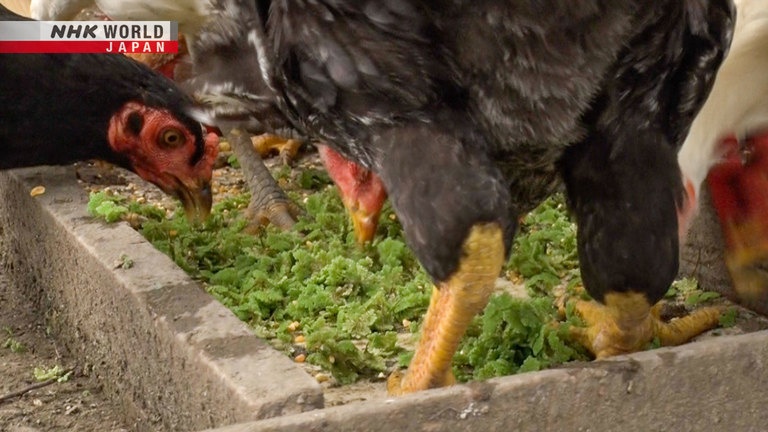Making Food Waste Useful: The Philippines
The Philippines' growing economy and population have led to a rise in trash, and it has become a serious social issue. Over half of this trash is food waste, and one woman hopes to use it to improve the lives of poor families. Lorilyn Daquioag uses microbes from the forest to break down food waste and produce a liquid solution that makes top-quality organic fertilizer. By distributing this for free to poor neighborhoods, she can track its efficacy on vegetables and flowers. The plan is to grow delicious, healthy vegetables for locals, and eventually produce a surplus to be sold at the market. Follow Lorilyn as she takes on the two-fold challenge of waste and poverty with a single solution.




Transcript
A waste disposal site in the Philippines, Southeast Asia.
As the country's economy and population have grown, so has the amount of waste.
Today, 1.6 million tons are produced each year, and it's a serious social problem.
Over half of that is food waste.
One woman plans to reuse this waste to improve people's lives.
Lorilyn Daquioag.
Lorilyn has developed a special liquid, that works with the help of microorganisms sourced from the forest.
Soaking food waste in this liquid breaks it down very quickly, creating a highly effective organic fertilizer.
Lorilyn's experiments have shown it helps vegetables and flowers
grow much faster and larger than they would with regular fertilizer.
By allowing poor families to take advantage of this solution,
Lorilyn can cut waste, while also making it easier to grow vegetables at home.
It feels good to help our kids.
To provide financial security.
Over 90% of the income goes to you.
Meet the woman with grand ambitions to tackle both poverty and waste, with a single solution.
Lasang, a coastal community in Davao, Mindanao Island.
It's home to 13,000 people.
Many local fishers make a living on these small boats.
Climate change and an increase in large foreign fishing vessels have led to a steady decline in catches.
Families grow vegetables in their gardens to make ends meet.
But this close to the sea, the soil is high in salt, making it hard to grow anything.
Lorilyn Daquioag began making regular visits to the town three months ago.
Community head Allan Simo-ag asked her to supply the liquid she developed.
Residents are testing it on their vegetables.
Good morning.
Did you try the sample?
How was it?
I've come to ask for your
feedback on the results.
Marietta has a large collection of potted plants and a small field, where she grows all kinds of vegetables.
Bok choy, radish, leek,
lettuce, cauliflower.
It's great. I even got some sweet potato.
The radish is growing well.
Nice! Salad, right?
The leaves turn a nice green.
So healthy.
My lettuces are bigger.
The fertilizer she's giving her vegetables is made from Lorilyn's food waste solution.
She adds it once a week around the plants' roots.
Lorilyn says that since her invention only uses natural ingredients, it doesn't harm animals, insects, or people.
It will faster the decomposition process, and will digest the biowaste,
and convert it into fertilizer for the crops to be stronger or to be bigger,
and also it helps for the faster cropping.
Lorilyn's firm operates out of a farming region three hours' drive from central Davao.
Vegetables are grown on the company lot, on an experimental farm.
Her company, Waste4Good, was named in the hopes of changing preconceptions around waste.
She founded it on her own in September 2021.
Today, she has ten employees.
Half are women, including the organic farming expert and head of accounting.
This is unusual in the Philippines, where female employment is low.
Their product is called eCAS, or Enhanced Compost Activator Solution.
Lorilyn developed it to turn food waste into good quality fertilizer.
Since launching commercially last year, it's become a hit product, and the startup's revenue has jumped by a factor of 10.
The product's efficacy comes from microbes Lorilyn sources from the forest.
She gathers the samples in these containers, though the exact process is a corporate secret.
The tubular coring devices are left for two weeks to collect microbes from the soil.
From the millions of microbes collected, Lorilyn selectively grows the ones she needs.
She has experimented with various combinations to find the most effective solution.
So this eCAS is composed of seven microbes.
So, the seven microbes here, most of them are for plant growth and also for the root's growth
and to make the crops greener and healthier, and produce more yield.
And also it helps for faster blooming for the crops.
So this is the trichoderma, so what this bacteria do,
is that it helps the soil to absorb the nutrients or,
it helps the crops to absorb the nutrients coming from the soil.
From there, the solution can be made into liquid fertilizer.
Simply mix it with food waste in a bucket, add ten parts water, and leave it to sit.
The microbes break down the waste, turning it into nutrients for plants.
The resulting fertilizer is again mixed with ten parts water, then given to crops.
Lorilyn explains that the microbes improve the soil, and make it easier to grow food.
String beans, or "sitaw," and this is applied.
As you can see, this is the not applied.
You can see the difference.
So, as you can see the outline is more longer here
and also look at the leaves, it's more greener.
And look at that. So the string beans is like one meter, long.
In Lorilyn's farm experiments, she has recorded 30% faster growth, and 30% larger crops.
Her solution is sold at around eleven US dollars per liter.
That's less than half the cost of most liquid fertilizers.
A liter of the product will make over 100 liters of fertilizer.
Lorilyn's profound interest in the environment and poverty has roots in her own background.
Her father was a poor furniture maker. He married young, and the family struggled.
Lorilyn and her three younger siblings often went hungry.
My classmates are eating nice lunch.
And then I just only have, like, dried fish.
And I can't buy this, but, um, my mother told me and my mother showed me:
If you want to succeed, study!
Because that's the only key for your success.
Lorilyn's dedication to academia landed her a scholarship at the University of the Philippines,
where she obtained her masters in electrical engineering.
After graduation, she worked as a quality control engineer at a Japanese automotive firm.
As the eldest child, she helped pay college fees for her younger siblings.
The issue of waste was another problem she became aware of in her youth.
Stinking trash littered the streets of her neighborhood,
and air and soil pollution grew worse every year.
Lorilyn kept searching for a way to tackle this issue.
Six years ago, after her youngest brother graduated university,
she left her job to take on this challenge.
Searching for a way to dispose of large quantities of food waste, Lorilyn landed on microbes.
She analyzed soil samples from farms and forests, and studied them in depth.
This was the foundation of her solution.
In 2021, she applied to a government-sponsored competition for social entrepreneurs.
She won a support grant of 10,000 US dollars, which she used to establish Waste4Good.
She eats vegetables from the company fields every day.
Lorilyn lives next door to the company, along with her husband, who is in the military, and their son.
Her mother lives nearby.
Naturally, she reuses all her vegetable peels and scraps.
This container is a special composter made and sold by her firm.
A small tap at the bottom of the container makes it easy to access the liquid fertilizer.
Ydrael! Dinner time!
Ydrael is nine years old.
He's another big source of inspiration for Lorilyn's current work.
Parents want the best
for their kids.
I want a sustainable environment.
Once that's gone, it will be
near impossible to get back.
Lorilyn is also experimenting with growing crops in dense urban areas.
A library in central Davao.
The roof is dedicated to a demonstration farm, set up by Lorilyn and the city government.
They're testing whether Lorilyn's fertilizer will improve yields in small private gardens, or even verandas.
It began four months ago.
Small planters grow basil, rosemary, and other herbs, alongside 30 varieties of vegetables and flowers.
A group is visiting from Manila.
Citrus! Calamansi, yeah, that's good.
And then the ginger, nice.
This one is ladyfingers, okra.
This is very good. Very nice, nutritious.
You don't need to go to the market to buy the...
for some vegetables for the ingredients.
So you can pick it, you can harvest it on your own rooftop!
That's good, that's the good...
- We should try this one.
- Oh yes, at home.
See, you also want to plant like this one.
Small, but like this.
- Because our house...
- It helps a lot.
This woman is picking handfuls of basil.
She works at the cafe on the first floor of the building.
The cafe uses plants from the farm in their salads and other dishes.
Food waste from the cooking and the large quantities of used coffee grounds
are turned into liquid fertilizer, and returned to the rooftop farm.
The cafe is another part of Lorilyn and the government's plan.
A major fast food chain has even expressed interest in this virtuous cycle.
In the seaside community of Lasang, a new project is underway involving a group of local women.
It's a cooperative farm.
Three months ago, Lorilyn began a new experiment on this abandoned land.
Members of the community joined in.
All of the workers are women.
Many are looking for work, but have had little success.
Now they enjoy this fun, communal opportunity.
They're currently growing ten vegetable varieties, including tomato, bitter gourd, lettuce, and bellpeppers.
Once they have a greater yield, they can sell any surplus at the market, which will help family finances.
Community head Allan has high hopes for the women.
We wanted to empower women, and we wanted to ensure that they would also be able to contribute.
The immediate need of the family, which is food.
Husband could not claim they were the only one working for the family. Their wife also.
A general meeting is held after the work is done.
The farm co-op's name is unveiled: 'Bayanihan Cooperative Women's Farm.'
The Tagalog word "bayanihan" refers to 'the spirit of communal unity.'
150 women are taking part.
1, 2, 3, 4, welcome!
It's Lorilyn's first project working with so many women.
Are there moms here?
We get up early every morning.
Cook the rice, clean the house.
It feels good to help our kids.
To provide financial security.
Over 90% of the income goes to you.
Hello.
A few days later, Lorilyn visits a livestock farm in Lasang.
She wants to propose new ways of using her solution.
Richard began raising pigs two years ago.
He used to work as a day laborer on a coconut farm, but work dried up during the pandemic,
forcing him to find another way to provide food for his family.
Today he has eight pigs, and eight newborn piglets.
How are they? Pretty big.
It's going well, but it's expensive.
The pigs can be sold for 170 dollars each after six months.
But 60% of this revenue will disappear on feed.
Lorilyn has brought him a plant to try adding to the pigs' diet.
It's used for chicken feed.
It's full of calcium.
Protein content too, 30-40%.
Organic, so it should improve
the flavor of the meat too.
Azolla is an aquatic fern grown on a pond in Lorilyn's experimental farm.
It's widely used to feed geese and ducks.
When Lorilyn's fertilizer was added to the pond, the plant grew three times as quickly.
The farm's chickens are particularly enamored with it!
Richard takes an interest in Lorilyn's proposal.
Like this, or mixed into the feed?
Let's see if they'll eat it as is.
Richard gives the pigs some azolla.
They're eating.
This will save on feed costs!
Lorilyn decides to grow the aquatic fern in the fish ponds at the cooperative farm.
Azolla can also be used to feed fish.
By regularly adding the firm's fertilizer, they can grow large amounts of the fern.
Locals can use it to feed their chickens or pigs.
Two years since she founded Waste4Good, Lorilyn is working at a much grander scale.
But she still faces one major hurdle.
The fertilizer used in Lasang and the Davao library is provided for free.
It makes no profit for the company.
Naturally I have to pay
the folks who work for me.
So we're applying for a grant
until we can secure sales.
Lorilyn has to grow sales of her company's product.
Today, she and two staff are visiting a cooperative group of 300 cocoa farmers.
Cocoa beans are the key ingredient in chocolate and a major export crop.
Davao grows 80,000 tons of cocoa each year.
However only the bean itself is used - the fruit and bean shell are thrown away.
If this waste can be turned into liquid fertilizer, the farm's costs will go down,
and it'll be able to sell its beans on the global market as organic.
It's two birds with one stone.
If we can produce organically, grow or produce chocolate,
we will be helping the small farmers, who are delivering beans, cacao beans with us.
We can buy it at a higher price.
And we can increase the livelihood.
Lorilyn hands out samples of her solution to staff, and explains how to use it.
Once they're convinced it works, she can expect regular sales.
Lorilyn has a trusted financial advisor in the Philippine capital of Manila.
Oscar Torralba, an executive at an economic association.
He's very interested in the future of Lorilyn's product.
He introduces Lorilyn to the former president of a major beverage company,
with a nationwide retail network of small stores.
Lorilyn explains how her solution works, along with some of the latest results from her experimental projects.
The market, outside the Philippines, is there.
Because everybody would like to see that we produce a product,
and this kind of idea must be given all the chances.
- Big opportunity.
- I hope you can help us.
Yes, I can help you as far as developing a supply chain of the product,
bringing it to the market, and then building the brand for the product; I can help you.
Both are willing to provide support in selling domestically and globally,
once they are able to confirm the experimental data.
Lorilyn's old school is in the suburbs of Davao.
She's holding a special class on organic farming with her fertilizer.
She occasionally holds these classes in the hope that the young students develop an interest in
environmental issues and recycling, and make efforts to cut down on waste.
Our efforts may be small
but they have a big impact.
I think it's life-saving for a broken food chain.
A way to cut down on food waste, help the environment, and enrich lives.
The seeds Lorilyn and her team are planting are sure to continue growing.